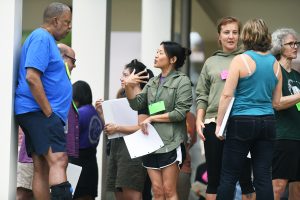Although the last day of any experience is often bittersweet, our potluck dessert table made…
Daily Manaʻo for Cohort Kumukahi March 2024 – Thursday
Thursday, March 21, 2024
Thursday is Isms Day! This was one of my favorite days as we finally were more comfortable with each other back at our lovely UH Mānoa campus. We opened with another iteration of our Piko Exercise, this time by focusing on the ʻili ʻāina within Mānoa as the place located at the center of the piko. Our campus is located among several ʻili ʻāina, and so we were really encouraging one another to think very specifically about the pilina we have to the ʻāina that is foundational to our campus.
We also had the great pleasure of featuring and hearing from Kumu Candace Fujikane as she spoke about the isms. (For the sake of brevity, we use the term “isms” to refer to the interlocking systems of oppression such as structural and systemic racism, individual racism, and settler colonialism.) To exhibit further the constantly changing nature of kuleana, the clicker for the projector wasn’t working, so I, myself a haumāna of Kumu Candace, offered to run her slideshow from the computer. Because I’ve listened to her presentations before, I was most familiar with her speaking style and the general pacing of her slides, so naturally I was able to fulfill that small kuleana to assist my kumu.
During her time with us, she spoke about her kuleana with such truth and honesty that we can’t help but appreciate her and the conviction that she brings to her work. In her assessing her positionality as she took a stand against the wind turbines in Kahuku, she had accepted her kuleana to take someone else’s place and be arrested in their stead. Candace exemplifies someone who is constantly refining and defining her kuleana to Hawaiʻi, so when a cohort member asked her a question about what they should do as a settler and whether it’s their responsibility to leave Hawaiʻi, she took the opportunity to affirm the importance of asking their question: Don’t leave, or else who will take their place? Someone who might not be asking the same critical questions.
In the afternoon, we then split into groups and were released into self-guided walking tours of our campus. We featured three different paths, and each route had a pre-recorded audio to accompany the walk throughout the buildings. Some features mentioned in the walking tours are more noticeable than others—and we were encouraged to think about visibility and legibility on campus. As I walked with some of our cohort members, we discussed how the building where they work is located in two separate ʻili ʻāina. Because that building is located in the somewhat liminal space of straddling the border of two ʻili, they were able to recognize the reason why it’s always raining on one side of the building but not the other. And as I encouraged them to think more about how they are able to observe the weather patterns of the places they frequent, I also mentioned that although there are certain disconnects that we might notice in our daily lives, we are all still connected despite the illusion of separation. The isms by nature are so divisive—they tell us we are separated when we are not. Although the rain stops at the edge of a section of land, we know that the ʻāina continues to facilitate the movement and flow of water, albeit through different means and in a neighboring ʻili ʻāina.

